“The Black Cultural Experience”: 10 Must-Visit Attractions In Greensboro NC
GREENSBORO, NC – If ‘Black History 365’ wasn’t already trademarked, Visit Greensboro NC, the agency that markets Greensboro, should jump right on that slogan. This Guilford County city has nearly 20 Black cultural attractions, most in a two-mile radius. Having gone to Greensboro in the past mostly for concerts, football games, and a golf tournament once a year, I was excited when Visit Greensboro NC invited me for a visit on Dec. 2-3, 2022.
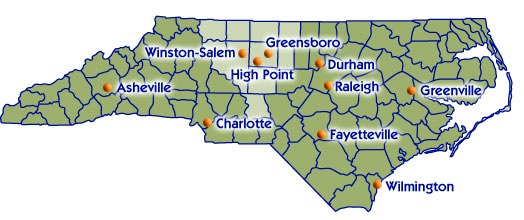 Greensboro, nicknamed The Gate City, is centrally located in North Carolina’s picturesque heartland. With an estimated population of 301,695 for 2021, Greensboro is the third largest city in the state. Seven colleges and universities are located inside the city limits, including HBCUs N.C. A&T State University and Bennett College. The 22,000+ seat Greensboro Coliseum built in 1959 used to be the largest single-seat arena in the nation. Now it’s the 2nd largest in the nation and the 6th largest in the world.
Greensboro, nicknamed The Gate City, is centrally located in North Carolina’s picturesque heartland. With an estimated population of 301,695 for 2021, Greensboro is the third largest city in the state. Seven colleges and universities are located inside the city limits, including HBCUs N.C. A&T State University and Bennett College. The 22,000+ seat Greensboro Coliseum built in 1959 used to be the largest single-seat arena in the nation. Now it’s the 2nd largest in the nation and the 6th largest in the world.
“The Black Cultural Experience”
Visit Greensboro Marketing Assistant Abigail Phillips masterfully arranged tours of 10 of Greensboro’s Black History sites and meals along with overnight accommodations at Black-owned establishments. Nine of the African American cultural sites toured were in Greensboro and the last stop was in Gibsonville, a town in Guilford County 10 miles from downtown Greensboro. All of the sites are family-friendly, and definitely educational, with most having free admission. I couldn’t get to one of the destinations in Greensboro as the streets were blocked on both days due to the city’s holiday festivities taking place.
May I suggest when you are in Greensboro for a day (or two) for “The Black Cultural Experience” that you use this list as your guide? Some of the places are within walking distance of each other. Here are the nine places I visited in the order I visited them (not in order of importance, by any means):
The Historic Magnolia House
442 Gorrell Street
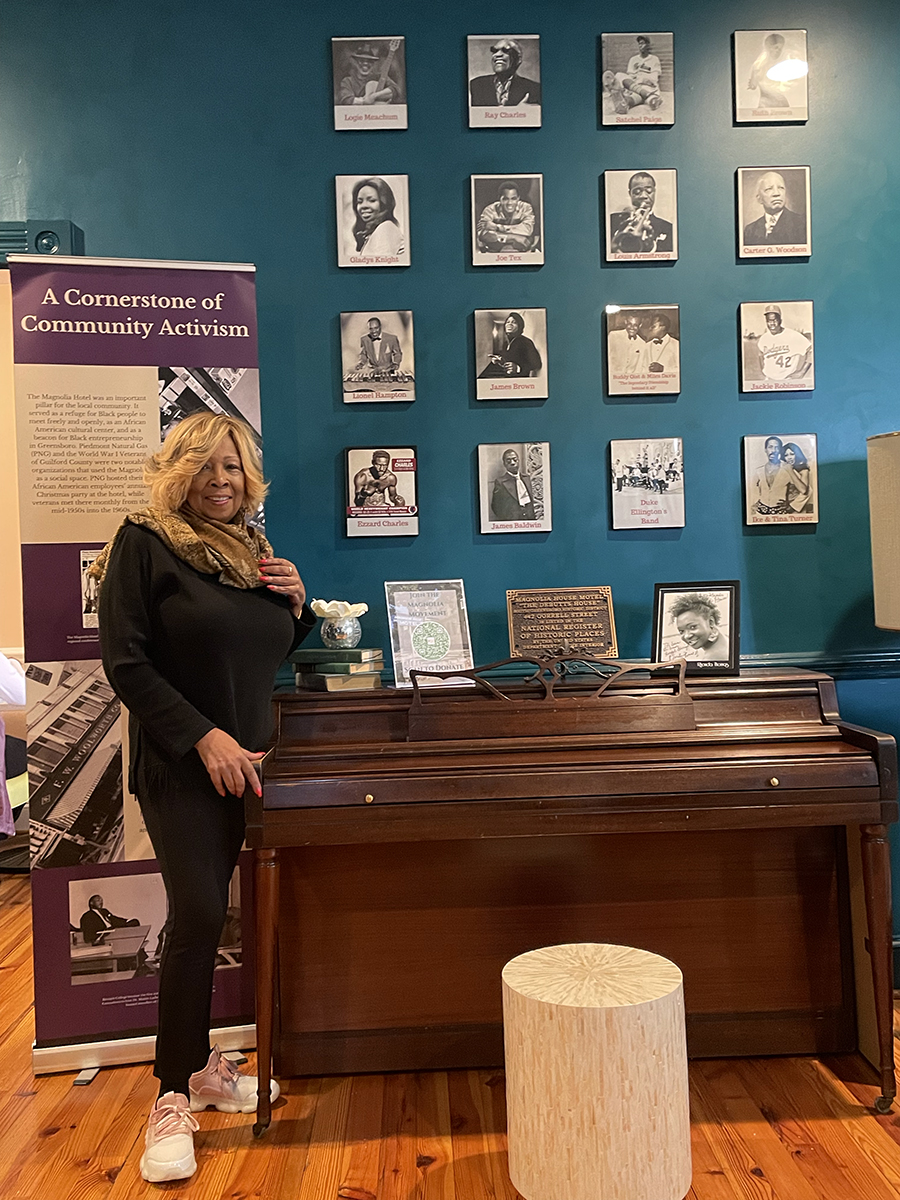
A bed and breakfast, restaurant, and events venue, The Historic Magnolia House is one of four Green Book sites in North Carolina still in operation. It was a popular destination for African American travelers who were not allowed to share the same accommodations as Caucasians, including the same eating and drinking facilities, during segregation in America in the mid-twentieth century. Many African Americans of renown stayed here, including James Brown, Ray Charles, Ruth Brown, Ike and Tina Turner, Joe Tex, Carter G. Woodson, and Jackie Robinson.
Also, many families of college students attending such schools as Bennett College and North Carolina A&T State University stayed here as well. It is also a place for wedding celebrations and other formal gatherings and events. The Historic Magnolia House (known by its formal name, the Daniel D. Debutts House) is on the National Register of Historic Places and is in the South Greensboro National Register Historic District.
When I entered the lobby area of the bed and breakfast, I felt the warmth and knew right away I was in a very special place. It is beautifully restored with attention to detail. The menu is ‘soulful, elegant southern cuisine’ and is available for dinner on Friday nights and Brunch on Saturdays and Sundays. Just the dining experience alone is worth the trip.
I was checked into The Legends room, one of the four themed rooms available. This one pays homage to iconic athletes such as Jackie Robinson and Satchel Paige. I sat down with the current owner, Natalie Pass-Miller, to learn more about the rich history of The Historic Magnolia House.
The Historic Magnolia House | Green Book Hotel in Greensboro, NC | “The Black Cultural Experience”
The International Civil Rights Center and Museum
134 S Elm Street
The first stop on the tour was the iconic landmark F.W. Woolworth’s site which is now the home of the International Civil Rights Center & Museum (ICRCM). On February 1, 1960, the A&T Four — four college freshmen who attended N.C. Agricultural & Technical College (now N.C. A&T State University) — conducted a sit-in at a whites-only lunch counter in Woolworth’s, carried out with colleagues at Bennett College. The fast-spreading Sit-In Movement ignited by the Greensboro protests served as a historical inflection point, renewing the Civil Rights Movement as a whole.

Sit-In Movement, Inc. was founded in 1993 to acquire and restore the F.W. Woolworth’s site and to establish ICRCM as a monument to the bravery and initiative of visionary young advocates of social justice. The International Civil Rights Center & Museum opened in 2010 as a comprehensive museum of the Civil Rights Movement and an innovative educational organization devoted to understanding and advancing civil and human rights in this country and the world. This restored lunch counter is preserved in its original location. The ICRCM’s permanent galleries, The Battlegrounds, with the Museum’s 13 permanent exhibitions include captivating audio/video narratives, pictorials, artifacts, video re-enactments, and interactive components.
ICRCM offers virtual and in-person tours. Walk-ins are welcomed, though reservations are encouraged. I recommend making a reservation for the 75-minute Staff-Guided Tour. This interactive, immersive experience includes an on-site, small-group, fully staff-guided excursion through the entire permanent Museum collection, including “The Battlegrounds.”
African American Atelier
Located in the Greensboro Cultural Center
200 N Davie St #14
Unfortunately, the streets were closed and I was not able to visit the art gallery. According to their website, the African American Atelier was created to provide a much-needed safe place for African American artists and artists of color to present their work in a professional gallery. Throughout the years the gallery has strived to provide inclusive and thought-provoking exhibitions that allow artists to be proud of their roots and their cultures. They are committed to supporting and presenting the work of artists of color while exposing, educating, and engaging the residents of Guilford County. Focusing on Awareness, Authenticity, and Enlightenment the Atelier seeks to enhance the visibility and exposure of African American artists and artists of color in Greensboro, NC.
Greensboro Four Mural
Windsor Recreation Center
1601 E Gate City Blvd

Painted by Nils Westergard, this mural is a recreation of a photo of four NC A&T students, Jibreel Khazan (then known as Ezell Blair Jr.), David Richmond, Franklin McCain, and Joseph McNeil, who would become known as the A&T Four or the Greensboro Four, at a Greensboro sit-in at Woolworth’s in 1960. Greensboro has a collection of over 150 works of public art for the community to enjoy.
Dame’s Chicken and Waffles
301 Martin Luther King Jr Dr.
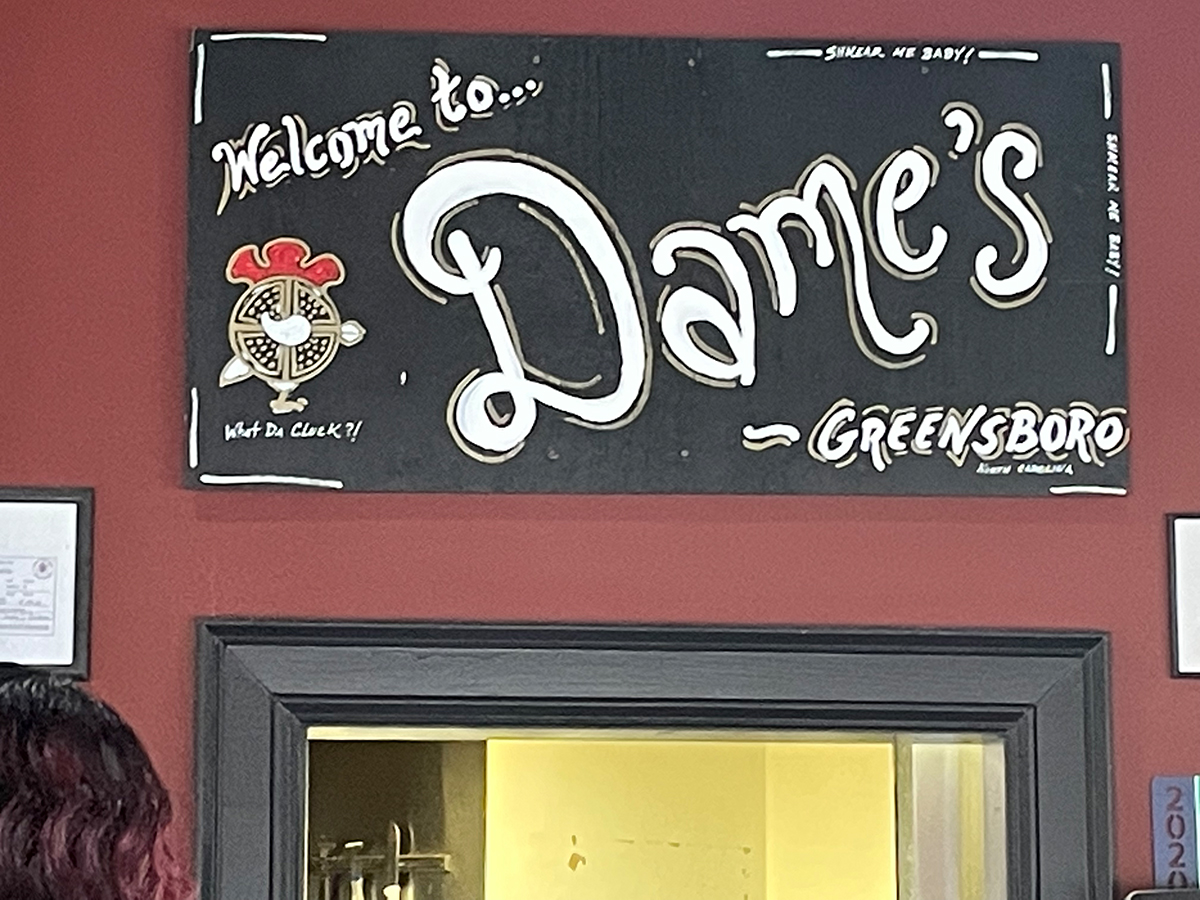 Next stop…lunch at the renowned Dame’s Chicken and Waffles. Started in Durham, the restaurant, in addition to the Durham site, now has locations in Cary, Chapel Hill, and Greensboro. The name tells you their specialty, but know this place is great for breakfast, brunch, and/or dinner. Dame’s pairings are world-class, comfort food combinations meant to fulfill your appetite and heart’s desires. From “first-timers” to “barnyard veterans”, Dame’s “Almost” World Famous Chicken & Waffle inspirations are truly palette-pleasing pairings that offer something special for all comers. Definitely try the assortment of drizzles and schmears (sweet crème butters delicately whipped with the freshest, natural ingredients).
Next stop…lunch at the renowned Dame’s Chicken and Waffles. Started in Durham, the restaurant, in addition to the Durham site, now has locations in Cary, Chapel Hill, and Greensboro. The name tells you their specialty, but know this place is great for breakfast, brunch, and/or dinner. Dame’s pairings are world-class, comfort food combinations meant to fulfill your appetite and heart’s desires. From “first-timers” to “barnyard veterans”, Dame’s “Almost” World Famous Chicken & Waffle inspirations are truly palette-pleasing pairings that offer something special for all comers. Definitely try the assortment of drizzles and schmears (sweet crème butters delicately whipped with the freshest, natural ingredients).
February One (Greensboro Four Monument)
Located in front of NC A&T’s Dudley Memorial Building
202 University Circle
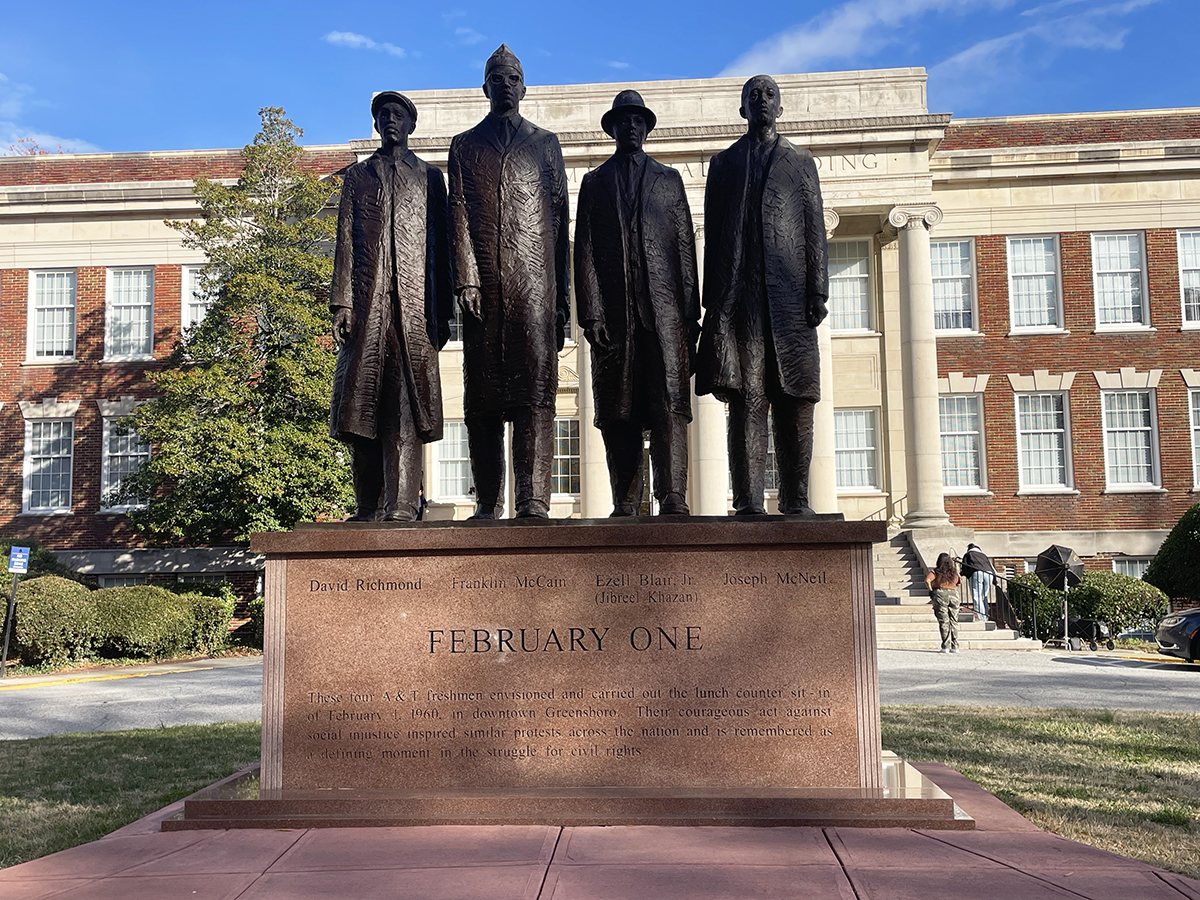
I’ve seen photos of this monument but it’s the first time I’ve actually visited. It’s awe-inspiring. February One is the name of the 2002 monument dedicated to four NC A&T students, Jibreel Khazan (then known as Ezell Blair Jr.), Franklin McCain, Joseph McNeil, and David Richmond. This monument provides a larger-than-life portrayal of the four NC A&T students who became known as the “Greensboro Four” for their sit-in at Woolworth’s department store in 1960. The figures are depicted walking out of Woolworth after their protest. Located in front of NC A&T’s Dudley Building, the statue took more than 6,000 pounds of clay to create and stands fifteen feet tall. NC A&T Chancellor James Renick proposed the idea in 2001.
NC A&T University Galleries
Located in NC A&T’s Dudley Memorial Building
202 University Circle
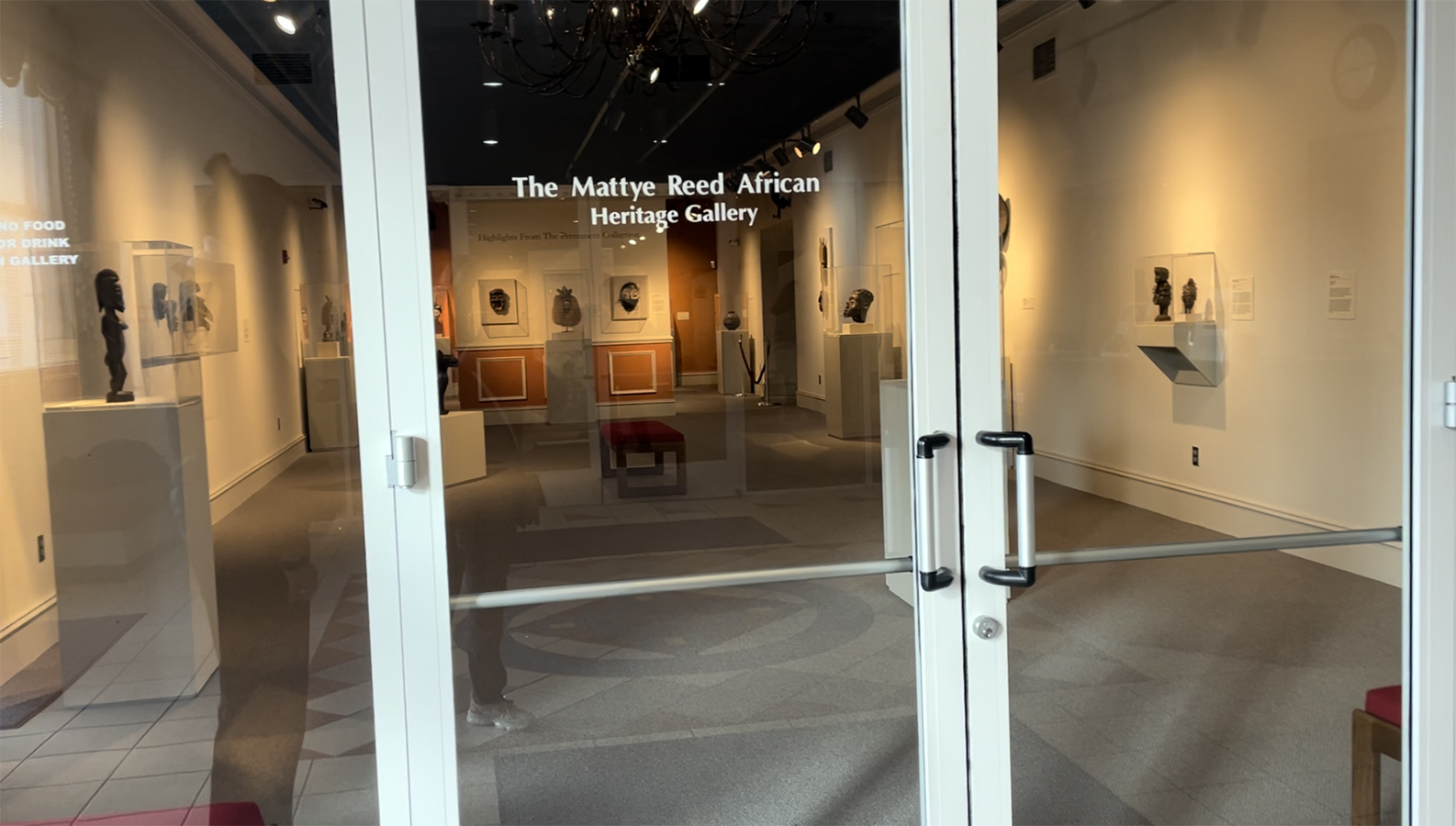
The University Galleries at A&T play an integral role in supporting its mission of providing cultural exposure to the art of the African Diaspora. The Mattye Reed African Heritage and H.C. Taylor campus art galleries are located on the main level of the Dudley Memorial Building. As part of the university and surrounding communities, the University Galleries are committed to increasing cultural competency and intellectual dialogue about the art and culture of people from the African diaspora through the exhibition of art, artifacts, and material culture. At the time of my visit, ‘We Built This’ was the traveling exhibit in the H.C. Taylor Gallery. The exhibit for Spring 2023 has not been announced yet.
Gallery hours are 10 am to 5 pm on weekdays and Saturdays by appointment. Exhibits are free and open to the public as well as campus visitors. The University Galleries at A&T curator Amy Schwartzott, PhD., tells us more about the Galleries and their history.
University Galleries at NC A&T | Greensboro, NC | “The Black Cultural Experience”
Guilford Woods
Underground Railroad Educational Trail
Guilford College campus
5800 W. Friendly Ave.
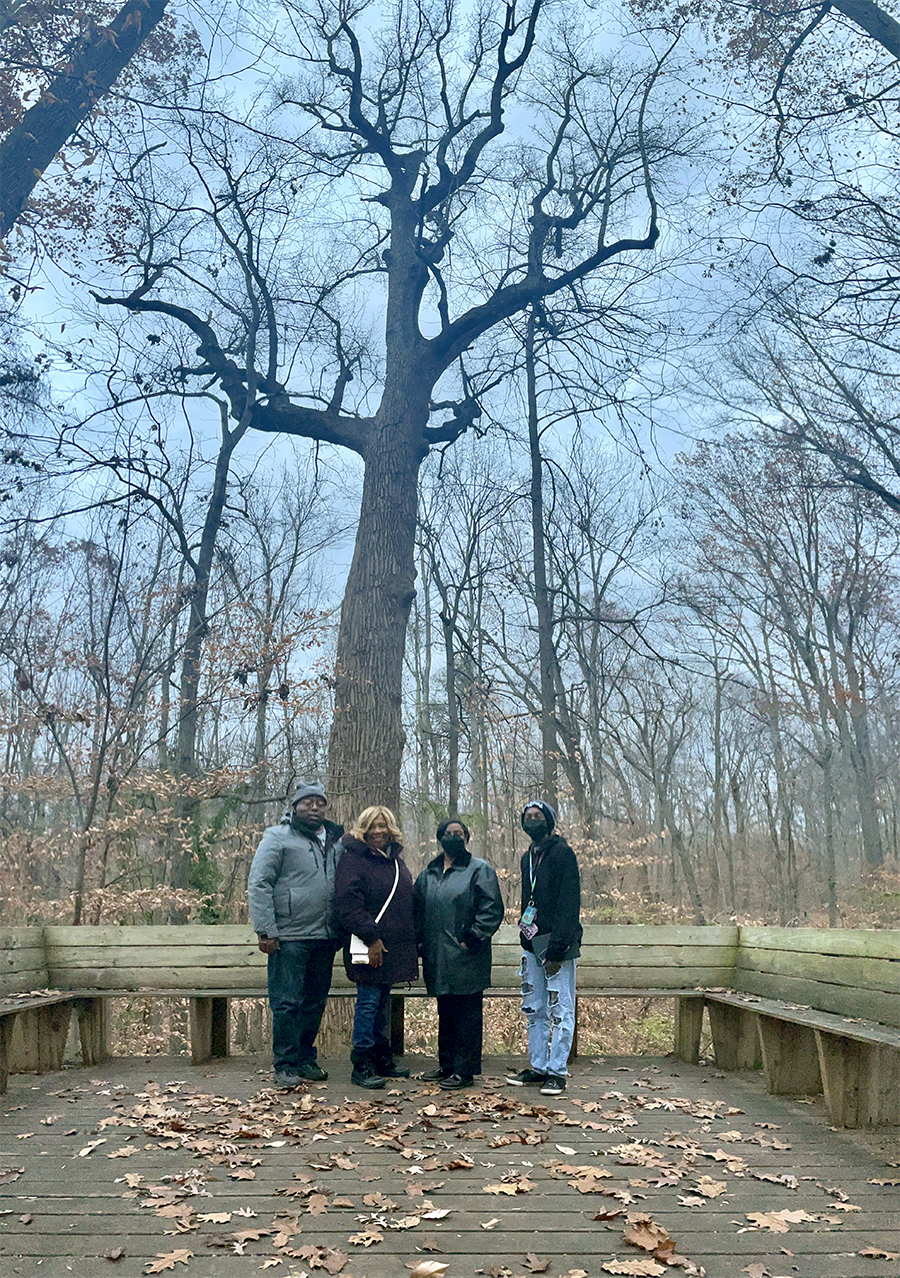

My last stop for the day before dinner was on the campus of Guilford College. Guilford Woods is a 240-acre old-growth forest with at least one champion tree standing as a silent witness to Underground Railroad activities. The Land of Saura and Keyawee peoples was settled by European American Friends (Quakers) in the 1700s. Known as the New Garden Woods in the 1800s, this is felt as a sacred place. Located within the historically Quaker New Garden/Guilford College community, the site of the former College farm served as a refuge for enslaved Africans seeking freedom via the Underground Railroad and Quaker men escaping the Civil War Confederate draft in the 1800s.
The 1.5-hour tour started at 4 pm so it was beginning to get dark before we finished. I felt like I was truly making my way North to freedom. The Underground Railroad Tree, a tulip poplar, dating back to the 1800s, was present during the documented operation of the Underground Railroad in Guilford County (1819-1852). The Trail to the champion tree is 0.3 miles one-way. It includes uneven surfaces with an accessible viewing platform and seating at the end. Please wear shoes you don’t mind getting muddy.
Amaria Nelson, a Friends Center Fellow at Guilford College, conducted the tour and provided great background information.
Underground Railroad in Guilford College Woods | Greensboro, NC | “The Black Cultural Experience”
Gillispie Golf Course
306 E. Florida Street
 My first stop on Saturday morning was Gillespie Golf Course…not for golf, but to learn the history of the integration of the golf course. On Dec. 7, 1955, six Black Greensboro men, known as The Greensboro Six, initiated the difficult process of integrating Gillespie Golf Course with an act of civil disobedience. Gillespie, originally called Gillespie Park, is Greensboro’s oldest city-owned course, however, it was operated as a private facility by a group of Caucasian citizens who restricted play to so-called members and their guests. In other words, everybody’s tax dollars maintained it, but everybody who was paying taxes on it then couldn’t play it.
My first stop on Saturday morning was Gillespie Golf Course…not for golf, but to learn the history of the integration of the golf course. On Dec. 7, 1955, six Black Greensboro men, known as The Greensboro Six, initiated the difficult process of integrating Gillespie Golf Course with an act of civil disobedience. Gillespie, originally called Gillespie Park, is Greensboro’s oldest city-owned course, however, it was operated as a private facility by a group of Caucasian citizens who restricted play to so-called members and their guests. In other words, everybody’s tax dollars maintained it, but everybody who was paying taxes on it then couldn’t play it.
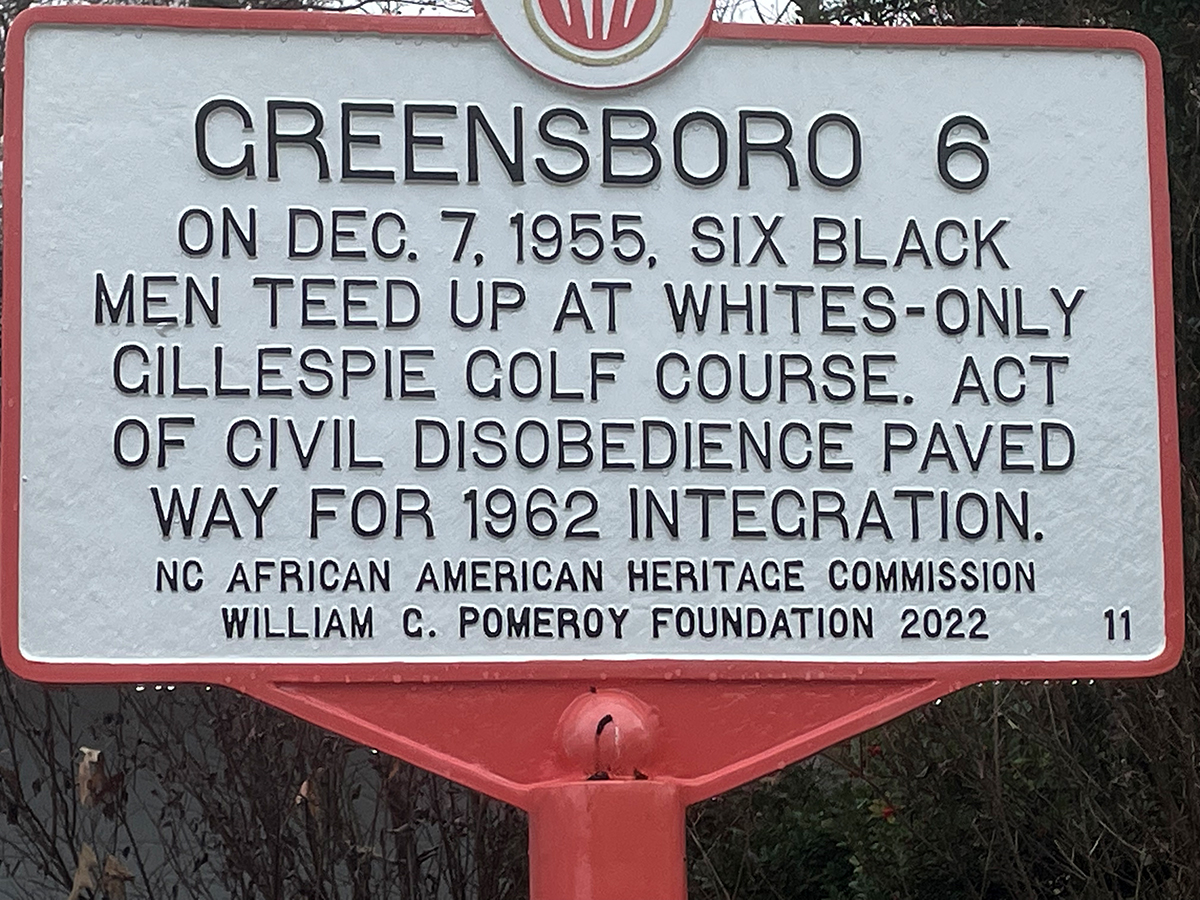 The Greensboro Six paid their 75 cents each to play and teed up. They were arrested for trespassing which carried a 30-day jail sentence. The struggle moved to the courts, eventually argued before the U.S. Supreme Court. They lost the case but due to a related federal civil court decision, Gillespie was to be integrated. On Dec. 7, 1962, a new City Council voted to open the course to all Greensboro residents.
The Greensboro Six paid their 75 cents each to play and teed up. They were arrested for trespassing which carried a 30-day jail sentence. The struggle moved to the courts, eventually argued before the U.S. Supreme Court. They lost the case but due to a related federal civil court decision, Gillespie was to be integrated. On Dec. 7, 1962, a new City Council voted to open the course to all Greensboro residents.
Gillespie eventually became a nine-hole course, with the land of the other nine holes sold for housing. But city recreation leaders brainstormed a system in 1991 where alternate tees on each hole created a 6,400-yard, par-72 course with different lengths or pars on each nine. A First Tee facility, driving range, and short course are located next door. A cafeteria-style restaurant, called the Gillespie Grill, is located in the small, one-story clubhouse, with reasonably priced “authentic, soulful, and tasty” menu items. It costs $22 to play 18 holes including a golf cart.
After a “spectacular” Brunch back at The Historic Magnolia House, I headed out to the last stop of the tour.
Charlotte Hawkins Brown Museum & State Historic Site
6136 Burlington Rd
Gibsonville, NC 27249

 Founded in 1902 by Dr. Charlotte Hawkins Brown, Palmer Memorial Institute transformed the lives of more than 2,000 African American students. Today, according to the museum’s website, the campus provides the setting where visitors can explore this unique environment where boys and girls lived and learned during the greater part of the 20th century. The museum links Dr. Brown and Palmer Memorial Institute to the larger themes of African American history, women’s history, social history, and education, emphasizing the contributions African Americans made in North Carolina.
Founded in 1902 by Dr. Charlotte Hawkins Brown, Palmer Memorial Institute transformed the lives of more than 2,000 African American students. Today, according to the museum’s website, the campus provides the setting where visitors can explore this unique environment where boys and girls lived and learned during the greater part of the 20th century. The museum links Dr. Brown and Palmer Memorial Institute to the larger themes of African American history, women’s history, social history, and education, emphasizing the contributions African Americans made in North Carolina.
For more information on more African American cultural sites and other attractions in Greensboro, North Carolina, click here.


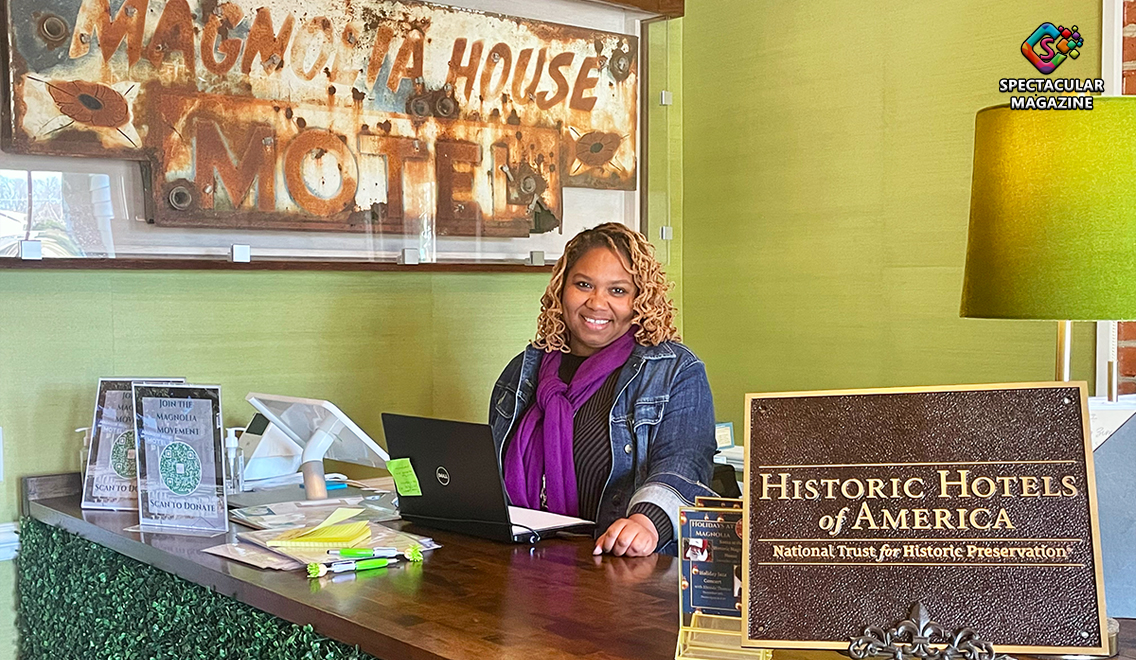
4 thoughts on ““The Black Cultural Experience”: 10 Must-Visit Attractions In Greensboro NC”
Comments are closed.